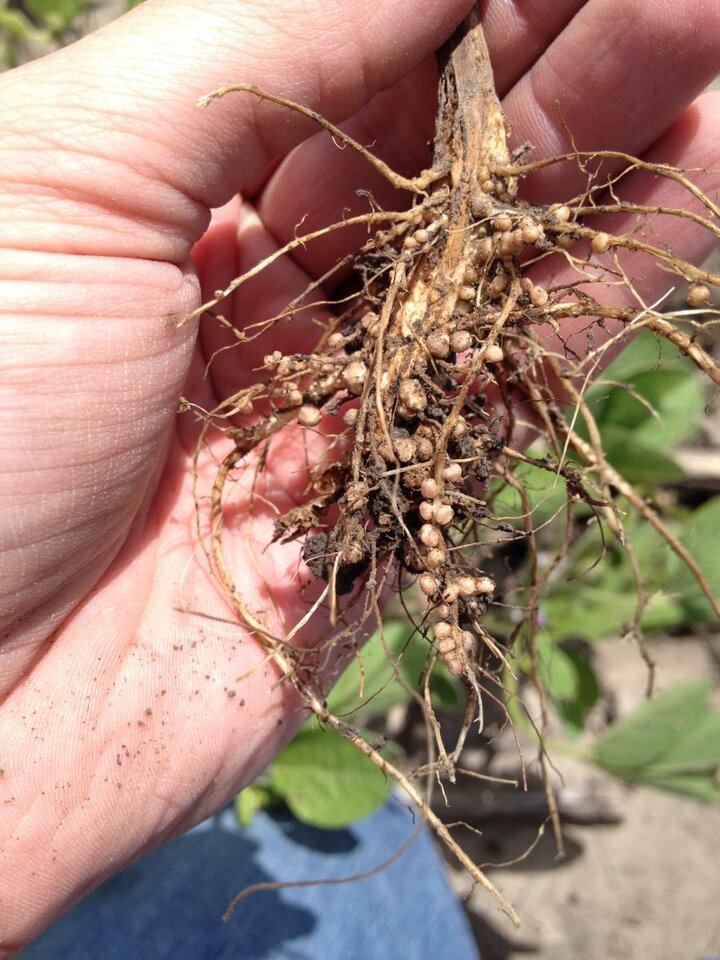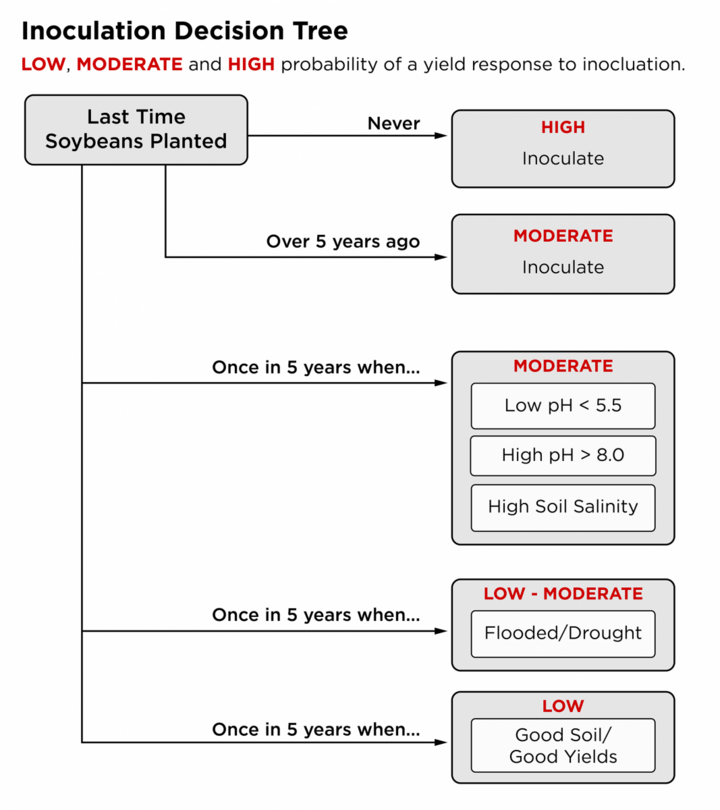Nebraska farmers must scrutinize inputs and focus on finding profit for their estimated 5.7 million soybean acres in 2017. Among the many springtime decisions farmers make is whether to inoculate their soybeans. Based on information from farmers, agronomists, and researchers, follow these steps when deciding whether to inoculate soybeans:
- Understand soybean nitrogen needs and the product label
- Place each of your fields into one of the following four categories to estimate probability of a yield response
- Use data to guide your decision
Nitrogen Fixation from Bacteria is Important
The process of fixing nitrogen in the soil air to ammonia occurs through the symbiotic relationship between soybeans and the Bradyrhizobium species, a bacteria within the nodules of soybean roots (Figure 1). Soybeans get needed nitrogen and the bacteria get some carbohydrates in return.
This process provides soybean plants 46%-74% of the N they need; the remaining amount is taken up from the soil (Salvagiotti 2008). A 70-bushel-per-acre soybean crop takes up roughly 330 lb N/acre in the aboveground portion of the plant, roughly equivalent to the nitrogen demand of a 245-bushel-per-acre corn crop. Many products state they’ll provide increased microbial activity, microbial health, and plant health. Make sure your inoculation product contains Bradyrhizobium japonicum cells.
Estimating Probability of a Yield Response
Place each of your fields into Category 1, 2, 3, or 4 described below.
Field Category 1: No previous history of soybeans and inoculation:
High Probability of Yield Response
In situations where soybeans have never been grown, yield increases of as much as 49 bushels per acre were measured in Nebraska fields with the addition of inoculant (Elmore 1984). However, more modest yield increases of 1 to 10 bushels per acre are expected. Yield effects are largely dependent on the nitrogen supply from soils and the relative increase in nitrogen fixation.

Field Category 2 (Moderate Probability of a Yield Response):
More than five years since soybeans were last planted
The three most common situations in Nebraska where soybeans may benefit from inoculation are when they are planted
- after five or more years of continuous corn,
- after alfalfa, or
- in land coming out of CRP.
Most university guidelines suggest inoculating if it has been more than five years since soybeans were last grown in the field. An inoculation study was imposed from 2009 to 2011 within a long-term (initiated in 1983) crop rotation and tillage study in Wisconsin. Researchers in this study (Marburger 2016) measured a two-bushel per acre yield increase with inoculation (Optimize) after five years of continuous corn production when averaged across tillage/crop rotations. A 2009 Iowa study reported inoculation increased soybean yield two bushels per acre on land coming out of pasture that had not been cropped for at least 20 years (Ruiz Diaz 2009). Also, in a long-term study in Saunders County, Nebraska, no yield response to inoculation was measured even after 28 years of continuous grain sorghum production (Mason 2016).

Field Category 3 (Moderate to Low Probability of a Yield Response):
Soybeans have been in rotation once in every five years, but there have been poor soil conditions for bacteria survival
Several environmental factors can cause poor nodulation, decrease nitrogen fixation, and reduce survival of these bacteria.
- Non-Optimal Soil pH. Low soil pH can decrease nodulation, nitrogen fixation, and survival of various strains. Ideal pH is near 6.8. Soil pH less than 6.0 can decrease root hair modification needed for the formation of nodules (Duzan 2004). Therefore, following economic thresholds for lime application when soil pH decreases to 5.6-5.8 also manages soil bacteria. High soil pH (>8.0) can also decrease nodulation, nitrogen fixation, and survival of these bacteria.
- High Soil Salinity. High soil EC (unknown threshold) can also decrease nodulation, nitrogen fixation, and survival of these bacteria.
- Floods, Droughts, and Soil Texture. Fields flooded for more than one week decrease nitrogen fixation and can decrease survival of bacteria because bacteria need oxygen. However, two recent research studies suggest not being overly confident in assuming a yield response to inoculants after floods (Furseth 2011, Wilson 2014). On the other end of the soil moisture scale, research (Barthelemy-Delaux 2014) shows that four- and eight-week droughts decrease Bradyrhizobium japonicum populations on both silt loam and sand soils (sand soils were more negatively impacted); however, decreases in B. japonicum were not large and the researchers suggested that growers likely would not need to inoculate the soil after a drought like 2012.
Field Category 4 (Low Probability of a Yield Response):
Soybean in rotation once in every five years with good soil conditions for bacteria survival
The probability of a yield response in fields with a recent history of soybeans is extremely low unless the field is affected by the environmental factors in Field Category 3. An eight-year study (2000-2008) testing 51 inoculant products in 73 experiments conducted in Wisconsin, Iowa, Indiana, Minnesota, and Nebraska resulted in average yield response of 0 bu/ac (De Bruin 2010).
Some still advocate for inoculating with more effective nitrogen-fixing strains of these bacteria over common indigenous strains, e.g., Bradyrhizobium japonicum Bj123 (Shiro 2013), in the Midwest even when environmental conditions have been conducive for nitrogen fixation. In the 2000 to 2008 study, new inoculant products and strains were used. Of the 10 most widely tested products, yields were not influenced in fields with a recent history of soybeans. This is likely due to highly competitive indigenous strains diminishing potential gains from applying more effective strains.
Nebraska Farmers Making Their Own Data-Driven Decisions
Nebraska farmers have conducted their own studies on the need to inoculate soybeans through the Nebraska On-Farm Research Network from 1992 through 2016 (Table 1). Using the new searchable database at resultsfinder.unl.edu, you can review the data for yourself by selecting Crop = Soybeans and Sub Topic = [Crop Management – Inoculant]. Only 1 of the 17 on-farm studies resulted in a yield increase attributed to soybean inoculation (bolded in Table 1). Also, the cost of inoculant products varied ($0.44 to $4.00/acre) within these on-farm research studies. View specific treatment costs at resultsfinder.unl.edu.
Summary
If you have managed soil pH well, planted soybeans recently, have medium to heavy textured soils, and have not experienced extended droughts or floods, direct your money away ($2/ac to $4/ac) from inoculating soybeans and move it to other management options that have an improved chance of return.
Additional Resources
For more information on soybean inoculation, read these Nebraska Extension NebGuides:
- Soybean Inoculation: Understanding the Soil and Plant Mechanisms Involved (NebGuide 1621)
- Soybean Inoculation: Applying the Facts to Your Fields (NebGuide 1622)
| Year | County | Yield (bu/ac) No inoculation | Yield (bu/ac) With Inoculant (Product 1) | Yield (bu/ac) With Inoculant (Product 2) |
|---|---|---|---|---|
| 1992 | Lancaster | 45.6 | 44.9 | 46.7 |
| 1998 | Saunders | 50 | 50 | 50 |
| 1999 | Saunders | 58 | 58 | - |
| 2001 | Lancaster | 49 | 48 | 47 |
| 2001 | Saunders | 61 | 61 | - |
| 2002 | Saunders | 65 | 67* | - |
| 2003 | Lancaster | 39 | 37 | 40 |
| 2003 | Saunders | 57 | 58 | - |
| 2005 | Saunders | 51 | 52 | 51 |
| 2009 | Saunders | 71 | 71 | - |
| 2010 | Saunders | 59 | 58 | - |
| 2010 | Saunders | 72 | 70 | - |
| 2012 | York | 69.3 | 69.3 | - |
| 2012 | Hamilton | 73.0 | 75.9 | - |
| 2013 | Hamilton | 83.2 | 81.9 | - |
| 2013 | Hamilton | 84.2 | 82.3 | - |
| 2013 | Butler | 55.4 | 55.4 | - |
| *Yield increase due to inoculation. | ||||
References
De Bruin, J.L., P Pedersen, S.P. Conley, J.M. Gaska, S.L. Naeve, J.E. Kurle, R.W. Elmore, L.J. Giesler, and L.J. Abendroth. 2010. Probability of Yield Response to Inoculants in Fields with a History of Soybean. Crop Science 50:265-272.
Barthelemy-Delaux, C., D. Marburger, P. Delaux, S. Conley, and J. Ane. 2014. Effect of drought on Bradyrhizobium japonicum populations in Midwest soils. Plant Soil 382:165-173
Ruiz Diaz, D.A., P. Pedersen, and J.E. Sawyer. 2009. Soybean Response to Inoculation and Nitrogen Following Long-Term Grass Pasture. Crop Science 49:1058-1062. Crop Science 49:1058-1062.
Duzan, H.M., X. Zhou, A. Souleimanov, and D.L. Smith. 2004. Perception of Bradyrhizobium japonicum Nod factor by soybean [Glycine max (L.) Merr.[ root hair abiotic stress conditions. Journal of Experimental Botany 55:402: 2641-2646.
Elmore, R.W. 1984. Soybean Inoculation: When is it Necessary? NebGuide G84-737.
Furseth, B.J., S.P. Conley, and J.M. Ane. 2011. Soybean Response to Rhizobia on Previously Flooded Site in Southern Wisconsin. Agronomy Journal 103:573-576.
Marburger, D.A., S. Mourtzinis, J.M. Gaska, and S.P. Conley. 2016. Do Crop Rotation and Tillage Influence Soybean Seed-Applied Inoculant Decisions. Agronomy Journal 108:402-406.
Mason, S., T. Galusha, and Z. Kmail. 2016. Soybean Yield and Nodulation Response to Crop History and Inoculation. Agronomy Journal 108:309-312.
Shiro, S., S. Matsuura, Rina Saiki, G.C. Sigue, A. Yamamoto, Y. Umehara, M. Hayashi, and Y. Saeki. 2013. Genetic Diversity and Geographical Distribution of Indigenous Soybean-Nodulating Bradyrhizobia in the United States. Applied and Environmental Biology. 79:12:3610-3618.
Salvagiotti, F., K.G. Cassman. J.E. Specht, D.T. Walters, A. Weiss, and A. Dobermann. 2008. Nitrogen uptake fixation and response to fertilizer N in soybeans: A review. Field Crops Research 108:1-13.
Wilson, J. 2014. Returning Crop Production to Flooded Soils Following the 2011 Missouri River Flood. Nebraska Extension.

